Sajid Javed
Spatio-Temporal State Space Model For Efficient Event-Based Optical Flow
Jun 09, 2025Abstract:Event cameras unlock new frontiers that were previously unthinkable with standard frame-based cameras. One notable example is low-latency motion estimation (optical flow), which is critical for many real-time applications. In such applications, the computational efficiency of algorithms is paramount. Although recent deep learning paradigms such as CNN, RNN, or ViT have shown remarkable performance, they often lack the desired computational efficiency. Conversely, asynchronous event-based methods including SNNs and GNNs are computationally efficient; however, these approaches fail to capture sufficient spatio-temporal information, a powerful feature required to achieve better performance for optical flow estimation. In this work, we introduce Spatio-Temporal State Space Model (STSSM) module along with a novel network architecture to develop an extremely efficient solution with competitive performance. Our STSSM module leverages state-space models to effectively capture spatio-temporal correlations in event data, offering higher performance with lower complexity compared to ViT, CNN-based architectures in similar settings. Our model achieves 4.5x faster inference and 8x lower computations compared to TMA and 2x lower computations compared to EV-FlowNet with competitive performance on the DSEC benchmark. Our code will be available at https://github.com/AhmedHumais/E-STMFlow
CLDTracker: A Comprehensive Language Description for Visual Tracking
May 29, 2025Abstract:VOT remains a fundamental yet challenging task in computer vision due to dynamic appearance changes, occlusions, and background clutter. Traditional trackers, relying primarily on visual cues, often struggle in such complex scenarios. Recent advancements in VLMs have shown promise in semantic understanding for tasks like open-vocabulary detection and image captioning, suggesting their potential for VOT. However, the direct application of VLMs to VOT is hindered by critical limitations: the absence of a rich and comprehensive textual representation that semantically captures the target object's nuances, limiting the effective use of language information; inefficient fusion mechanisms that fail to optimally integrate visual and textual features, preventing a holistic understanding of the target; and a lack of temporal modeling of the target's evolving appearance in the language domain, leading to a disconnect between the initial description and the object's subsequent visual changes. To bridge these gaps and unlock the full potential of VLMs for VOT, we propose CLDTracker, a novel Comprehensive Language Description framework for robust visual Tracking. Our tracker introduces a dual-branch architecture consisting of a textual and a visual branch. In the textual branch, we construct a rich bag of textual descriptions derived by harnessing the powerful VLMs such as CLIP and GPT-4V, enriched with semantic and contextual cues to address the lack of rich textual representation. Experiments on six standard VOT benchmarks demonstrate that CLDTracker achieves SOTA performance, validating the effectiveness of leveraging robust and temporally-adaptive vision-language representations for tracking. Code and models are publicly available at: https://github.com/HamadYA/CLDTracker
Multi-Resolution Pathology-Language Pre-training Model with Text-Guided Visual Representation
Apr 26, 2025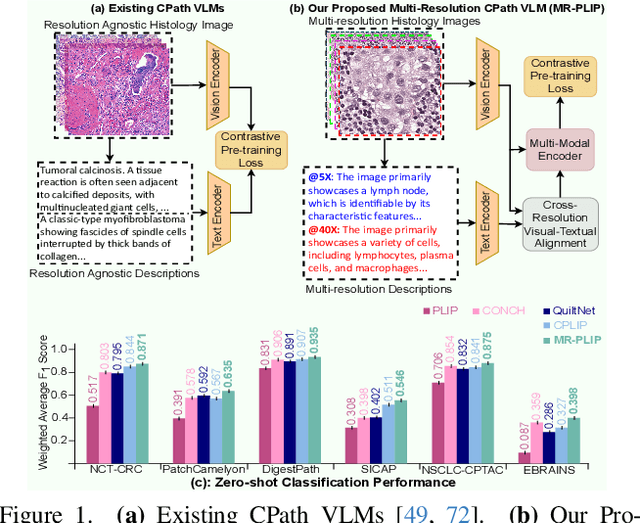
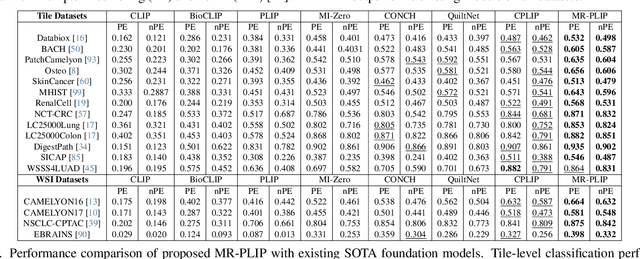
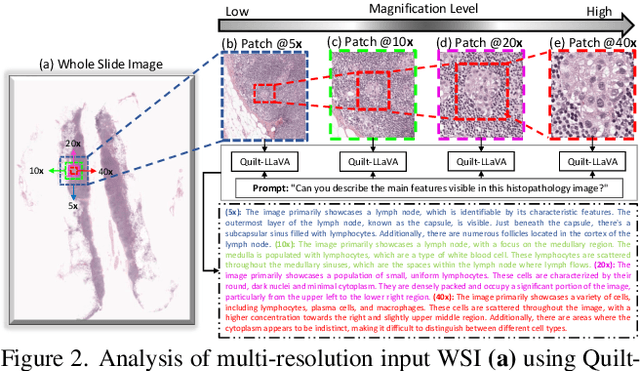
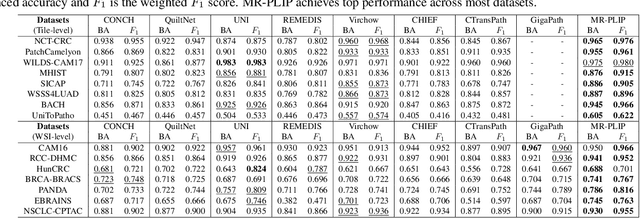
Abstract:In Computational Pathology (CPath), the introduction of Vision-Language Models (VLMs) has opened new avenues for research, focusing primarily on aligning image-text pairs at a single magnification level. However, this approach might not be sufficient for tasks like cancer subtype classification, tissue phenotyping, and survival analysis due to the limited level of detail that a single-resolution image can provide. Addressing this, we propose a novel multi-resolution paradigm leveraging Whole Slide Images (WSIs) to extract histology patches at multiple resolutions and generate corresponding textual descriptions through advanced CPath VLM. We introduce visual-textual alignment at multiple resolutions as well as cross-resolution alignment to establish more effective text-guided visual representations. Cross-resolution alignment using a multimodal encoder enhances the model's ability to capture context from multiple resolutions in histology images. Our model aims to capture a broader range of information, supported by novel loss functions, enriches feature representation, improves discriminative ability, and enhances generalization across different resolutions. Pre-trained on a comprehensive TCGA dataset with 34 million image-language pairs at various resolutions, our fine-tuned model outperforms state-of-the-art (SOTA) counterparts across multiple datasets and tasks, demonstrating its effectiveness in CPath. The code is available on GitHub at: https://github.com/BasitAlawode/MR-PLIP
snnTrans-DHZ: A Lightweight Spiking Neural Network Architecture for Underwater Image Dehazing
Apr 13, 2025Abstract:Underwater image dehazing is critical for vision-based marine operations because light scattering and absorption can severely reduce visibility. This paper introduces snnTrans-DHZ, a lightweight Spiking Neural Network (SNN) specifically designed for underwater dehazing. By leveraging the temporal dynamics of SNNs, snnTrans-DHZ efficiently processes time-dependent raw image sequences while maintaining low power consumption. Static underwater images are first converted into time-dependent sequences by repeatedly inputting the same image over user-defined timesteps. These RGB sequences are then transformed into LAB color space representations and processed concurrently. The architecture features three key modules: (i) a K estimator that extracts features from multiple color space representations; (ii) a Background Light Estimator that jointly infers the background light component from the RGB-LAB images; and (iii) a soft image reconstruction module that produces haze-free, visibility-enhanced outputs. The snnTrans-DHZ model is directly trained using a surrogate gradient-based backpropagation through time (BPTT) strategy alongside a novel combined loss function. Evaluated on the UIEB benchmark, snnTrans-DHZ achieves a PSNR of 21.68 dB and an SSIM of 0.8795, and on the EUVP dataset, it yields a PSNR of 23.46 dB and an SSIM of 0.8439. With only 0.5670 million network parameters, and requiring just 7.42 GSOPs and 0.0151 J of energy, the algorithm significantly outperforms existing state-of-the-art methods in terms of efficiency. These features make snnTrans-DHZ highly suitable for deployment in underwater robotics, marine exploration, and environmental monitoring.
Underwater Image Enhancement by Convolutional Spiking Neural Networks
Mar 26, 2025



Abstract:Underwater image enhancement (UIE) is fundamental for marine applications, including autonomous vision-based navigation. Deep learning methods using convolutional neural networks (CNN) and vision transformers advanced UIE performance. Recently, spiking neural networks (SNN) have gained attention for their lightweight design, energy efficiency, and scalability. This paper introduces UIE-SNN, the first SNN-based UIE algorithm to improve visibility of underwater images. UIE-SNN is a 19- layered convolutional spiking encoder-decoder framework with skip connections, directly trained using surrogate gradient-based backpropagation through time (BPTT) strategy. We explore and validate the influence of training datasets on energy reduction, a unique advantage of UIE-SNN architecture, in contrast to the conventional learning-based architectures, where energy consumption is model-dependent. UIE-SNN optimizes the loss function in latent space representation to reconstruct clear underwater images. Our algorithm performs on par with its non-spiking counterpart methods in terms of PSNR and structural similarity index (SSIM) at reduced timesteps ($T=5$) and energy consumption of $85\%$. The algorithm is trained on two publicly available benchmark datasets, UIEB and EUVP, and tested on unseen images from UIEB, EUVP, LSUI, U45, and our custom UIE dataset. The UIE-SNN algorithm achieves PSNR of \(17.7801~dB\) and SSIM of \(0.7454\) on UIEB, and PSNR of \(23.1725~dB\) and SSIM of \(0.7890\) on EUVP. UIE-SNN achieves this algorithmic performance with fewer operators (\(147.49\) GSOPs) and energy (\(0.1327~J\)) compared to its non-spiking counterpart (GFLOPs = \(218.88\) and Energy=\(1.0068~J\)). Compared with existing SOTA UIE methods, UIE-SNN achieves an average of \(6.5\times\) improvement in energy efficiency. The source code is available at \href{https://github.com/vidya-rejul/UIE-SNN.git}{UIE-SNN}.
AquaticCLIP: A Vision-Language Foundation Model for Underwater Scene Analysis
Feb 03, 2025



Abstract:The preservation of aquatic biodiversity is critical in mitigating the effects of climate change. Aquatic scene understanding plays a pivotal role in aiding marine scientists in their decision-making processes. In this paper, we introduce AquaticCLIP, a novel contrastive language-image pre-training model tailored for aquatic scene understanding. AquaticCLIP presents a new unsupervised learning framework that aligns images and texts in aquatic environments, enabling tasks such as segmentation, classification, detection, and object counting. By leveraging our large-scale underwater image-text paired dataset without the need for ground-truth annotations, our model enriches existing vision-language models in the aquatic domain. For this purpose, we construct a 2 million underwater image-text paired dataset using heterogeneous resources, including YouTube, Netflix, NatGeo, etc. To fine-tune AquaticCLIP, we propose a prompt-guided vision encoder that progressively aggregates patch features via learnable prompts, while a vision-guided mechanism enhances the language encoder by incorporating visual context. The model is optimized through a contrastive pretraining loss to align visual and textual modalities. AquaticCLIP achieves notable performance improvements in zero-shot settings across multiple underwater computer vision tasks, outperforming existing methods in both robustness and interpretability. Our model sets a new benchmark for vision-language applications in underwater environments. The code and dataset for AquaticCLIP are publicly available on GitHub at xxx.
Anomaly Detection for Industrial Applications, Its Challenges, Solutions, and Future Directions: A Review
Jan 20, 2025



Abstract:Anomaly detection from images captured using camera sensors is one of the mainstream applications at the industrial level. Particularly, it maintains the quality and optimizes the efficiency in production processes across diverse industrial tasks, including advanced manufacturing and aerospace engineering. Traditional anomaly detection workflow is based on a manual inspection by human operators, which is a tedious task. Advances in intelligent automated inspection systems have revolutionized the Industrial Anomaly Detection (IAD) process. Recent vision-based approaches can automatically extract, process, and interpret features using computer vision and align with the goals of automation in industrial operations. In light of the shift in inspection methodologies, this survey reviews studies published since 2019, with a specific focus on vision-based anomaly detection. The components of an IAD pipeline that are overlooked in existing surveys are presented, including areas related to data acquisition, preprocessing, learning mechanisms, and evaluation. In addition to the collected publications, several scientific and industry-related challenges and their perspective solutions are highlighted. Popular and relevant industrial datasets are also summarized, providing further insight into inspection applications. Finally, future directions of vision-based IAD are discussed, offering researchers insight into the state-of-the-art of industrial inspection.
Dehazing-aided Multi-Rate Multi-Modal Pose Estimation Framework for Mitigating Visual Disturbances in Extreme Underwater Domain
Nov 21, 2024



Abstract:This paper delves into the potential of DU-VIO, a dehazing-aided hybrid multi-rate multi-modal Visual-Inertial Odometry (VIO) estimation framework, designed to thrive in the challenging realm of extreme underwater environments. The cutting-edge DU-VIO framework is incorporating a GAN-based pre-processing module and a hybrid CNN-LSTM module for precise pose estimation, using visibility-enhanced underwater images and raw IMU data. Accurate pose estimation is paramount for various underwater robotics and exploration applications. However, underwater visibility is often compromised by suspended particles and attenuation effects, rendering visual-inertial pose estimation a formidable challenge. DU-VIO aims to overcome these limitations by effectively removing visual disturbances from raw image data, enhancing the quality of image features used for pose estimation. We demonstrate the effectiveness of DU-VIO by calculating RMSE scores for translation and rotation vectors in comparison to their reference values. These scores are then compared to those of a base model using a modified AQUALOC Dataset. This study's significance lies in its potential to revolutionize underwater robotics and exploration. DU-VIO offers a robust solution to the persistent challenge of underwater visibility, significantly improving the accuracy of pose estimation. This research contributes valuable insights and tools for advancing underwater technology, with far-reaching implications for scientific research, environmental monitoring, and industrial applications.
Hybrid-Neuromorphic Approach for Underwater Robotics Applications: A Conceptual Framework
Nov 21, 2024Abstract:This paper introduces the concept of employing neuromorphic methodologies for task-oriented underwater robotics applications. In contrast to the increasing computational demands of conventional deep learning algorithms, neuromorphic technology, leveraging spiking neural network architectures, promises sophisticated artificial intelligence with significantly reduced computational requirements and power consumption, emulating human brain operational principles. Despite documented neuromorphic technology applications in various robotic domains, its utilization in marine robotics remains largely unexplored. Thus, this article proposes a unified framework for integrating neuromorphic technologies for perception, pose estimation, and haptic-guided conditional control of underwater vehicles, customized to specific user-defined objectives. This conceptual framework stands to revolutionize underwater robotics, enhancing efficiency and autonomy while reducing energy consumption. By enabling greater adaptability and robustness, this advancement could facilitate applications such as underwater exploration, environmental monitoring, and infrastructure maintenance, thereby contributing to significant progress in marine science and technology.
Predicting the Best of N Visual Trackers
Jul 22, 2024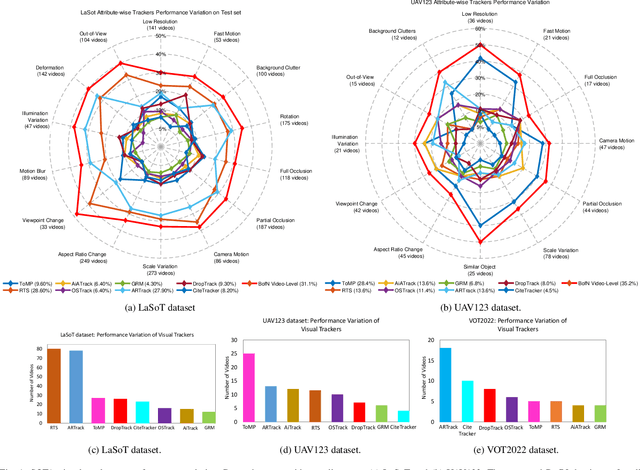

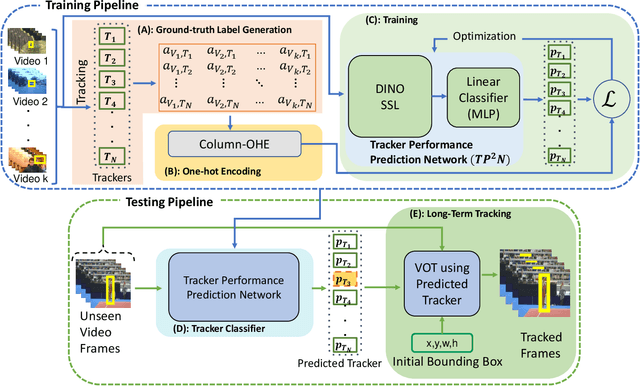

Abstract:We observe that the performance of SOTA visual trackers surprisingly strongly varies across different video attributes and datasets. No single tracker remains the best performer across all tracking attributes and datasets. To bridge this gap, for a given video sequence, we predict the "Best of the N Trackers", called the BofN meta-tracker. At its core, a Tracking Performance Prediction Network (TP2N) selects a predicted best performing visual tracker for the given video sequence using only a few initial frames. We also introduce a frame-level BofN meta-tracker which keeps predicting best performer after regular temporal intervals. The TP2N is based on self-supervised learning architectures MocoV2, SwAv, BT, and DINO; experiments show that the DINO with ViT-S as a backbone performs the best. The video-level BofN meta-tracker outperforms, by a large margin, existing SOTA trackers on nine standard benchmarks - LaSOT, TrackingNet, GOT-10K, VOT2019, VOT2021, VOT2022, UAV123, OTB100, and WebUAV-3M. Further improvement is achieved by the frame-level BofN meta-tracker effectively handling variations in the tracking scenarios within long sequences. For instance, on GOT-10k, BofN meta-tracker average overlap is 88.7% and 91.1% with video and frame-level settings respectively. The best performing tracker, RTS, achieves 85.20% AO. On VOT2022, BofN expected average overlap is 67.88% and 70.98% with video and frame level settings, compared to the best performing ARTrack, 64.12%. This work also presents an extensive evaluation of competitive tracking methods on all commonly used benchmarks, following their protocols. The code, the trained models, and the results will soon be made publicly available on https://github.com/BasitAlawode/Best_of_N_Trackers.
 Add to Chrome
Add to Chrome Add to Firefox
Add to Firefox Add to Edge
Add to Edge